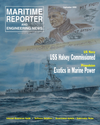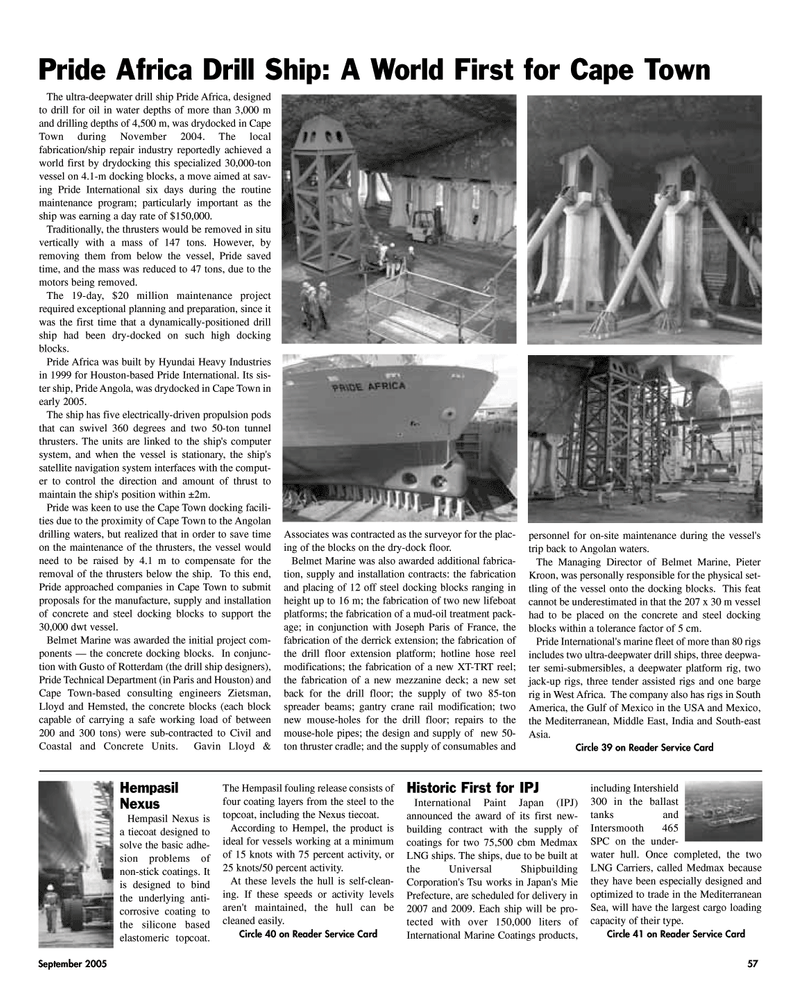
Page 57: of Maritime Reporter Magazine (September 2005)
Marine Propulsion Annual
Read this page in Pdf, Flash or Html5 edition of September 2005 Maritime Reporter Magazine
September 2005 57
The ultra-deepwater drill ship Pride Africa, designed to drill for oil in water depths of more than 3,000 m and drilling depths of 4,500 m, was drydocked in Cape
Town during November 2004. The local fabrication/ship repair industry reportedly achieved a world first by drydocking this specialized 30,000-ton vessel on 4.1-m docking blocks, a move aimed at sav- ing Pride International six days during the routine maintenance program; particularly important as the ship was earning a day rate of $150,000.
Traditionally, the thrusters would be removed in situ vertically with a mass of 147 tons. However, by removing them from below the vessel, Pride saved time, and the mass was reduced to 47 tons, due to the motors being removed.
The 19-day, $20 million maintenance project required exceptional planning and preparation, since it was the first time that a dynamically-positioned drill ship had been dry-docked on such high docking blocks.
Pride Africa was built by Hyundai Heavy Industries in 1999 for Houston-based Pride International. Its sis- ter ship, Pride Angola, was drydocked in Cape Town in early 2005.
The ship has five electrically-driven propulsion pods that can swivel 360 degrees and two 50-ton tunnel thrusters. The units are linked to the ship's computer system, and when the vessel is stationary, the ship's satellite navigation system interfaces with the comput- er to control the direction and amount of thrust to maintain the ship's position within ±2m.
Pride was keen to use the Cape Town docking facili- ties due to the proximity of Cape Town to the Angolan drilling waters, but realized that in order to save time on the maintenance of the thrusters, the vessel would need to be raised by 4.1 m to compensate for the removal of the thrusters below the ship. To this end,
Pride approached companies in Cape Town to submit proposals for the manufacture, supply and installation of concrete and steel docking blocks to support the 30,000 dwt vessel.
Belmet Marine was awarded the initial project com- ponents — the concrete docking blocks. In conjunc- tion with Gusto of Rotterdam (the drill ship designers),
Pride Technical Department (in Paris and Houston) and
Cape Town-based consulting engineers Zietsman,
Lloyd and Hemsted, the concrete blocks (each block capable of carrying a safe working load of between 200 and 300 tons) were sub-contracted to Civil and
Coastal and Concrete Units. Gavin Lloyd &
Associates was contracted as the surveyor for the plac- ing of the blocks on the dry-dock floor.
Belmet Marine was also awarded additional fabrica- tion, supply and installation contracts: the fabrication and placing of 12 off steel docking blocks ranging in height up to 16 m; the fabrication of two new lifeboat platforms; the fabrication of a mud-oil treatment pack- age; in conjunction with Joseph Paris of France, the fabrication of the derrick extension; the fabrication of the drill floor extension platform; hotline hose reel modifications; the fabrication of a new XT-TRT reel; the fabrication of a new mezzanine deck; a new set back for the drill floor; the supply of two 85-ton spreader beams; gantry crane rail modification; two new mouse-holes for the drill floor; repairs to the mouse-hole pipes; the design and supply of new 50- ton thruster cradle; and the supply of consumables and personnel for on-site maintenance during the vessel's trip back to Angolan waters.
The Managing Director of Belmet Marine, Pieter
Kroon, was personally responsible for the physical set- tling of the vessel onto the docking blocks. This feat cannot be underestimated in that the 207 x 30 m vessel had to be placed on the concrete and steel docking blocks within a tolerance factor of 5 cm.
Pride International's marine fleet of more than 80 rigs includes two ultra-deepwater drill ships, three deepwa- ter semi-submersibles, a deepwater platform rig, two jack-up rigs, three tender assisted rigs and one barge rig in West Africa. The company also has rigs in South
America, the Gulf of Mexico in the USA and Mexico, the Mediterranean, Middle East, India and South-east
Asia.
Circle 39 on Reader Service Card
Pride Africa Drill Ship: A World First for Cape Town
Hempasil
Nexus
Hempasil Nexus is a tiecoat designed to solve the basic adhe- sion problems of non-stick coatings. It is designed to bind the underlying anti- corrosive coating to the silicone based elastomeric topcoat.
The Hempasil fouling release consists of four coating layers from the steel to the topcoat, including the Nexus tiecoat.
According to Hempel, the product is ideal for vessels working at a minimum of 15 knots with 75 percent activity, or 25 knots/50 percent activity.
At these levels the hull is self-clean- ing. If these speeds or activity levels aren't maintained, the hull can be cleaned easily.
Circle 40 on Reader Service Card
Historic First for IPJ
International Paint Japan (IPJ) announced the award of its first new- building contract with the supply of coatings for two 75,500 cbm Medmax
LNG ships. The ships, due to be built at the Universal Shipbuilding
Corporation's Tsu works in Japan's Mie
Prefecture, are scheduled for delivery in 2007 and 2009. Each ship will be pro- tected with over 150,000 liters of
International Marine Coatings products, including Intershield 300 in the ballast tanks and
Intersmooth 465
SPC on the under- water hull. Once completed, the two
LNG Carriers, called Medmax because they have been especially designed and optimized to trade in the Mediterranean
Sea, will have the largest cargo loading capacity of their type.
Circle 41 on Reader Service Card
MR SEPTEMBER 2005 #8 (57-64).qxd 9/1/2005 3:30 PM Page 57

 56
56

 58
58
